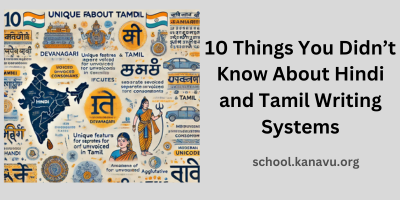The scripts of Hindi and Tamil are fascinating and incredibly rich, each with its own history and intricacies. While both belong to different language families (Indo-Aryan and Dravidian), their writing systems offer a delightful blend of artistic expression and logical structure. Whether you’re a student, a language enthusiast, or simply curious, here are 10 quirky and cool things you probably didn’t know about the Hindi and Tamil writing systems!
1. Hindi and Tamil: Two Scripts, One Purpose
Hindi and Tamil are written in two completely different scripts, but both serve the same purpose: they help convey the beauty and rhythm of spoken language through written symbols. Hindi uses the Devanagari script, while Tamil uses the Tamil script. Interestingly, both scripts evolved to represent their respective languages’ phonetic sounds, though the symbols look entirely different!
2. Devanagari: The Beauty of “Lines and Loops”
The Devanagari script used for Hindi is renowned for its distinctive horizontal line running across the top of letters. This feature makes the script look like a “series of connected loops and lines,” which gives it a unique visual appeal. It’s not just an artistic feature; it also helps bind the letters together, making reading easier for Hindi speakers.
3. Tamil: A Script Born from the Ancient Sangam Era
The Tamil script has an ancient lineage, dating back to the Sangam era (3rd century BCE to 3rd century CE). It’s one of the oldest written scripts still in use today! Unlike Devanagari, the Tamil script is a collection of curved shapes and symbols, often described as “gentle and flowing,” which is quite different from the more angular Devanagari.
4. Hindi: A Script That’s Full of “Syllables”
A cool thing about Hindi and the Devanagari script is that it is syllabic! In Devanagari, each character typically represents a consonant with an inherent vowel sound (usually “a”). For example, the letter “क” (ka) inherently carries the “a” sound. To change this vowel, you need to add “matras” or vowel markers. Fun, right?
5. Tamil: Where Every Character Is “One Sound”
Unlike Devanagari, Tamil script is much more “pure” in terms of phonetic representation. Each character in Tamil corresponds to one single sound, which makes it less complex for learners to pronounce. You won’t find an inherent vowel here—each character has a specific sound that is easy to associate with its shape!
6. Devanagari and Tamil: Both Have Their Own “Dotted” Letters
A fun fact is that both Hindi and Tamil scripts have dotted characters! In Devanagari, these dots appear at the top of certain letters, helping to differentiate between similar-looking characters. Meanwhile, in Tamil, dots can be added to letters for specific reasons, such as to create sounds used in more formal or old Tamil pronunciations.
7. Hindi and Tamil Scripts: They Both Have “Conjuncts”
Both scripts feature “conjuncts” (combined forms of letters). In Devanagari, this happens when two consonants combine to form a single, unique symbol—like “क्ष” (kṣa). Similarly, in Tamil, certain combinations of letters form ligatures that represent complex sounds, often seen in classical poetry or formal writing. How cool is that?
8. Tamil Doesn’t Need “Spaces” for Words
While Devanagari script uses spaces to separate words, Tamil script often does not use spaces between words. Instead, the Tamil script relies on the natural rhythm of the sentence and the shape of characters to convey meaning. It’s like a continuous flow of sound!
9. Hindi Names vs. Tamil Names: Same Sounds, Different Scripts!
Here’s a fun challenge: try writing a common name like “Raj” in both Devanagari and Tamil scripts! In Hindi, it’s written as राज, while in Tamil, it’s ராஜ். Even though the pronunciation is identical, the scripts are vastly different, reflecting the diversity of the writing systems.
10. Tamil and Hindi Have More Than 50 “Basic” Letters!
The complexity of Hindi and Tamil writing systems becomes more apparent when you realize that both scripts have over 50 basic characters! Devanagari has around 47 primary characters (including vowels and consonants), while Tamil has 12 vowels, 18 consonants, and additional combinations, bringing the total number of characters to over 50.
Conclusion
The Hindi and Tamil writing systems are not just practical ways of recording speech—they’re an intricate part of cultural identity. Whether you’re fascinated by the flowing curves of Tamil script or the horizontal elegance of Devanagari, there’s so much more to these scripts than meets the eye. So, the next time you read a Hindi or Tamil book, think about all the rich history and quirks behind the characters you’re reading!
Exploring these scripts isn’t just about mastering grammar or spelling—it’s about celebrating the creativity and history of language itself!
